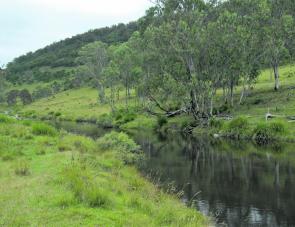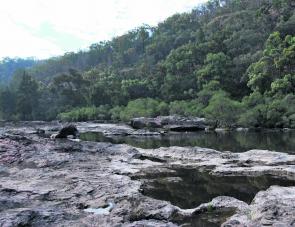For the sweet water fly angler Murray cod can be something of a challenge. The biggest issue is not getting the fish to take the fly but understanding their inland habitat sufficiently to make fishing worthwhile.
When referring to habitat I refer to streams; not impoundments where there’s far too much water between fish to make fly fishing viable.
Two decades back cod habitat was far more restricted than today. These attractive fish, with their greenish marbled tones and big black eyes, were pretty well confined to slower flowing western rivers well away from the Great Dividing Range. Stocking groups have these days extended cod habitat to take in most west flowing granite belt waters plus those on the main range’s western slopes.
There are fair smatterings of cod from around Stanthorpe, west to Texas and as far south as Pindari Dam, including the streams feeding into Pindari, northwest of Glen Innes.
These higher country stream fish are catchable, if one goes about it the right way, but it would be very optimistic to expect a hook up in every hole or back water. Same as other freshwater fly fishing pursuits, results depend on variables such as water height, the barometer reading, ambient water temperature and even the time of day.
And let’s not forget angler access. If that attractive looking tree fringed hole with its steep drop-off bank and bubbling head section is right by the side of the road one can bet it has been fished to perfection by a lot of anglers. Travelling to get away from pressure and adopting a flexible game plan from the outset are important tactics.
Big fat cod are mighty hard to come by in these high country waters where heavy stocking tends to stunt fish in some cases. With a legal size of 60cm, a keeper cod on fly is a very good fish by today’s standards. Additionally, the smaller ones are far more active and eager to play than their big brothers.
My thoughts on cod tackle are orientated towards the size of flies in use rather than the size of the stream’s inhabitants. From my experience a large cod fly (tied on a 4/0 hook) will ensure a hook up more rapidly than a small fly that can well be ignored by our quarry.
While a lot of cod I’ve taken on fly could be wrestled to the bank with a 7wt outfit, that same rod will struggle to cast a big fly like a 4/0 Gartside Gurgler, which is my mainstay cod fly these days. On those grounds, I recommend an 8-9wt rod as ideal; maybe even a 10wt if fishing big New England gorge holes where legal sized and larger fish are the norm.
A floating fly line to match the rod will make casting a bulky fly easier. Besides, having seen a lot of good wet flies snagged in cod country the move towards a floating fly has seen hook up rates as good as ever and a lot more excitement in this highly visual aspect of the game.
When cod are on the job and not simply lurking away under an over hanging bank or snag, they will readily come to the surface to have a whack at a Gartside, or at least have a look at it.
Once a cod’s whereabouts are known, the trick is to change the colour of the fly and cast from an entirely different angle after a small spell. I favour dark or even camo coloured Gurglers bodies. Buy the body form pre cut and shaped at a fly shop and simply tie in a choice of tail – usually some flash material plus a bit of rabbit fur strip – in various colours such as black, dark green, light green, even white, which then allows some choice on a choosey fish.
A rod length leader will be ideal with final tippet of around 7kg lest the action of the fly be inhibited. However, keep some heavier tippet handy in case a run of larger fish are found in totally new water.
There was a time when I believed cod could only be caught on fly when the water was clear, with visibility of least 40cm. For wet fly fishing maybe that’s ideal but when using the Gartside Gurgler even quite dirty water conditions can kick start a bite, especially if the stream has been clear for quite a while previously.
As always, with such apex predators activity will be usually best at early morning and very late afternoon, or when it’s raining. I know it’s not much fun slogging around trees and slippery banks in the rain but when a cod scoffs the Gartside with a big ‘glomp’ the rain is quickly overlooked.
Taking cod requires casting to every likely position, even the deeper parts of pools with three, maybe four, casts to the one spot and then moving on. Remember to keep the rod tip low at all times to keep slack out of the equation and only to work the Gartside gently, no big glugs or gurgles at all. At the take, strip strike. Don’t lift the rod until the weight of the fish is felt. Cod on fly? Why not!
Reads: 4010
The best of the best. High country cod water west of Glen Innes.

In gorge country it will pay to upgrade to 10wt tackle.

The author with a typical high country cod. It’s not a large fish but still fun on fly tackle.

A Gartside Gurgler as large as this one requires an 8wt rod to cast it.




